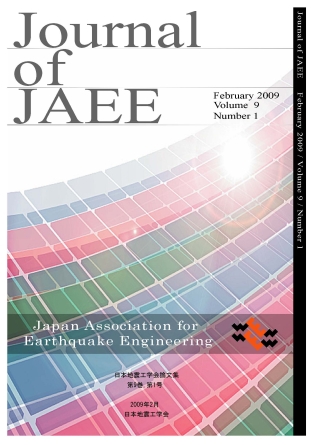
- Issue 6 Pages 6_1-
- Issue 5 Pages 5_1-
- Issue 4 Pages 4_1-
- Issue 3 Pages 3_1-
- Issue 2 Pages 2_1-
- Issue 1 Pages 1_1-
- |<
- <
- 1
- >
- >|
-
Hideharu SUGINO, Yuta ABE2022Volume 22Issue 4 Pages 4_1-4_22
Published: 2022
Released on J-STAGE: August 31, 2022
JOURNAL FREE ACCESSFor tsunamis caused by interplate earthquakes, we set probabilistic models by quantitatively evaluating the uncertainties associated with the models of the scaling law related to the seismic moment, the Gutenberg-Richter law related to the frequency of earthquake occurrence, and then we proposed a PTHA method that incorporated these probabilistic models. Furthermore, we applied the proposed method to off the coast of Fukushima Prefecture as the model site, considering other uncertainties associated with the arrangement pattern of the heterogeneous slip distribution and the tsunami propagation model, and analyzed the effects of the uncertainties on the PTHA results. We confirmed that the uncertainty associated with the scaling law had the most significant effect among the above uncertainties, and we could quantitatively show the impact using the ratio of the relative maximum water level of the 95% confidence curve and 50% one, and the Jensen-Shannon divergence.
View full abstractDownload PDF (3937K) -
Atsuko OANA, Toru ISHII, Yuki MIYASHITA, Kei FURUKAWA2022Volume 22Issue 4 Pages 4_23-4_38
Published: 2022
Released on J-STAGE: August 31, 2022
JOURNAL FREE ACCESSWe constructed ground motion evaluation models of maximum accelerations and response spectra by supervised machine learning based on the strong motion database. The normal logarithmic standard deviations of the ratios of the predicted values to the observed ones in our models are 0.18-0.21, which is less than the variation of the previous ground motion prediction equations. The generalizability of the model was tested using three additional test earthquakes that occurred later than the training dataset. The results showed that the prediction accuracy decreased for earthquakes with features that were not included in the training dataset, but the model with features based on prediction results by the previous ground motion prediction equation could compensate for the bias and lack of training data.
View full abstractDownload PDF (5315K) -
Takuma HASHIMOTO, Tadashi TAMURA, Yuki FURUSHIMA, Shigenobu MORI, Tais ...2022Volume 22Issue 4 Pages 4_39-4_55
Published: 2022
Released on J-STAGE: August 31, 2022
JOURNAL FREE ACCESSWe propose a simple method for determining, based on energy balance, the degree of damage to a medium/low-rise steel-framed building after an earthquake, and confirm that the method is likely to be usable in practice. We calculated total energy input, comprising foreshocks, the mainshock and aftershocks, using the cumulative energy spectrum. In addition, we compared results from time history response analysis using seismic vibration for design purposes as input with the results from the method we propose, and found that both methods yielded fairly consistent results, with differences in the number of stories or seismic vibration having little impact. Using observed waveforms from the Kumamoto earthquake, we examined the applicability of the method based on differences in earthquake order of occurrence and phase. With this method, we were able to track the progress with the degree of damage according to earthquake order of occurrence.
View full abstractDownload PDF (4428K) -
Junya SUGIMOTO, Mikio KOSHIHARA, Yukimori YANAGAWA, Yutaro SUMI2022Volume 22Issue 4 Pages 4_56-4_76
Published: 2022
Released on J-STAGE: August 31, 2022
JOURNAL FREE ACCESSDamage assumptions have been made in response to major earthquakes such as the Nankai Trough earthquake, but most of them only take into account the type of structure and the age of the building. On the other hand, it has been pointed out that earthquake damage is affected by the presence or absence of joint hardware and eccentricity. In this study, we classify wooden houses according to factors of seismic performance such as construction method, number of floors, weight, wall quantity, seismic elements, joints, eccentricity, and horizontal diaphragm, and show examples of calculation of standard load-deformation relationships according to these classifications and basic data.
View full abstractDownload PDF (4773K)
- |<
- <
- 1
- >
- >|